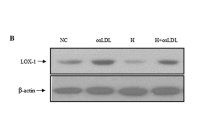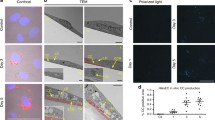Abstract
An important issue in atherosclerosis is the timing of intimal microvascular formation and its relation to the initiation of plaque formation. Monocytes and endothelial cells (ECs) are important cell components in these steps. Statins not only reduce atherogenic low density lipoprotein cholesterol, they also increase high density lipoprotein-cholesterol (HDL). Although a higher concentration of statin has an anti-proliferative effect, HDL is potentially mitogenic. Therefore, we examined the opposing effects of statin, Apo-AI, HDL and HDL fractions on cell proliferation and apoptosis in monocytes and on angiogenesis in ECs. A high concentration of simvastatin inhibited monocyte proliferation as evaluated by counting cell numbers using a hematocytometer. This inhibition was mainly blocked by the HDL3 subfraction. The same concentration of simvastatin induced apoptosis as assessed by the fluorescence-labeled annexin-V method through caspase-3 activation in monocytes. HDL inhibited simvastatin-induced apoptosis. In addition, HDL blocked simvastatin-inhibited angiogenesis in an in vitro model of EC tube formation. In conclusion, the compensatory balance between the effects of statin and HDL may play an important role in the formation of atherosclerotic lesions by affecting proliferation and apoptosis in monocytes and angiogenesis in ECs.
Similar content being viewed by others
References
Schaefer JR, Schweer H, Ikewaki K, et al. Metabolic basis of high density lipoproteins and apolipoprotein A-I increase by HMG-CoA reductase inhibition in healthy subjects and a patient with coronary artery disease. Atherosclerosis 1999;144:177–184.
Stein O, Stein Y. Atheroprotective mechanisms of HDL. Atherosclerosis 1999;144:285–301.
Mori S, Saito Y. Pleiotropic effects of statins. Nippon Rinsho 2002;60:875–81.
Masao T, Liao JK. Pleiotropic effects of 3-Hydroxy-3-Methylglutanyl Coenzyme A Reductase Inhibitors. Arterioscler Thromb Vasc Biol 2001;21:1712–1719.
Weis M, Heeschen C, Glassford AJ, et al. Statins have biphasic effects on angiogenesis. Circulation 2003;105:739–745.
Miura S, Fujino M, Matsuo Y, et al. High density lipoprotein-induced angiogenesis requires the activation of ras/MAP kinase in human coronary artery endothelial cells. Aterioscler Thromb Vasc Biol 2003;23:802–808.
Horrevoets AJ, Funtijn RD, van Zonneveld AJ, et al. Vasicular endothelial genes that are responsive to tumor necrosis factor-α in vitro are expressed in atherosclerotic lesions, including inhibitor of apoptosis protein-1, sannin, and two novel genes. Blood 1999;93:3418–3431.
Sugano M, Tsuchida K, Makino N. High-density lipoproteins protect endothelial cells from tumor necrosis factor-induced apoptosis. Biochemical and Biophysical Research Communications, 2000;272:872–876.
Erl W, Hristov M. HMG-CoA reductase inhibitors apoptosis in neointimaderived vascular smooth muscle cells. Atherosclerosis 2003;169:251–258.
Blanco-Cilio LM, Villa A, Ortego M, et al. 3-Hydroxy-3-methyl-glutaryl coenzume A reductase inhibitors, atrovastatin and simvastatin, induced apoptosis of vascular smooth muscle cells by downrebulation of Bcl-2 expression and Rho S prenylation. Atherosclerosis 2002;161:17–26.
Guijarro C, Blanco-Colio JM, Ortego M, et al. 3-Hydroxy-3-Methylglutaryl coenzyme a reductase and isoprenylation inhibitors induce apoptosis of vascular smooth muscle cells in culture. Circulation Research 1998;83:490–500.
Nofer JR, Levkau B, Wolinska I, et al. Supression of endothelial cell apoptosis by high density lipoproteins (HDL) and HDL-associated lysosphingolipids. The Journal of Biological Chemistry 2001;276:34480–34485.
Mineo C, Yuhanna IS, Quon MJ, et al. High density lipoprotein-induced endothelial nitric-oxide synthase activation is mediated by Akt and MAP kinases. Biological Chemistry 2003;278:9142–9149.
Manna SK, Mukhopadhyay A, Aggarwal BB. Reveratrol supresses TNF-induced activation of nuclear transcription factors NF-kB, activator protein-1, and apoptosis: Potential role of reactive oxygen intermediates and lipid peroxidation. The Journal of Immunology 2000;164:6509–6519.
Ouchi N, Kihara S, Arita Y, fOkamoto Y, et al. Adiponectin, an adipocyte-derived plasma protein, inhibits endothelial NF-kB signaling through a cAMP-dependent pathway. Circulation 2000;102:1296–1301.
Reimann FM, Herold G, Schneider A, Stange EF. Compartmentalization of cholesterol metabolism and cellular growth in cultured intestinal crypt cells. Biochim Biophys Acta 1991;1085:315–21.
Cohen DC, Massoglia SL, Gospodarowicz D. Correlation between two effects of high density lipoproteins on vascular endothelial cells. The induction of 3-hydroxy-3-methylglutaryl coenzyme a reductase activity and the support of cellular proliferation. The Journal of Biological Chemistry 1982;257:9429–9437.
Uittenbogaard A, Shaul PW, Yuhanna IS, et al. High density lipoprotein prevents oxidized low density lipoprotein-induced inhibition of endothelial nitric-oxide synthase localization and activation in caveolae. The Journal of Biological Chemistry 2000;275: 11278–11283
Author information
Authors and Affiliations
Rights and permissions
About this article
Cite this article
Fujino, M., Miura, Si., Tanigawa, H. et al. Counteracting Effects of High Density Lipoprotein-Cholesterol Subfractions on Statin-Induced Growth Arrest. Cardiovasc Drugs Ther 19, 113–118 (2005). https://doi.org/10.1007/s10557-005-0427-x
Issue Date:
DOI: https://doi.org/10.1007/s10557-005-0427-x




